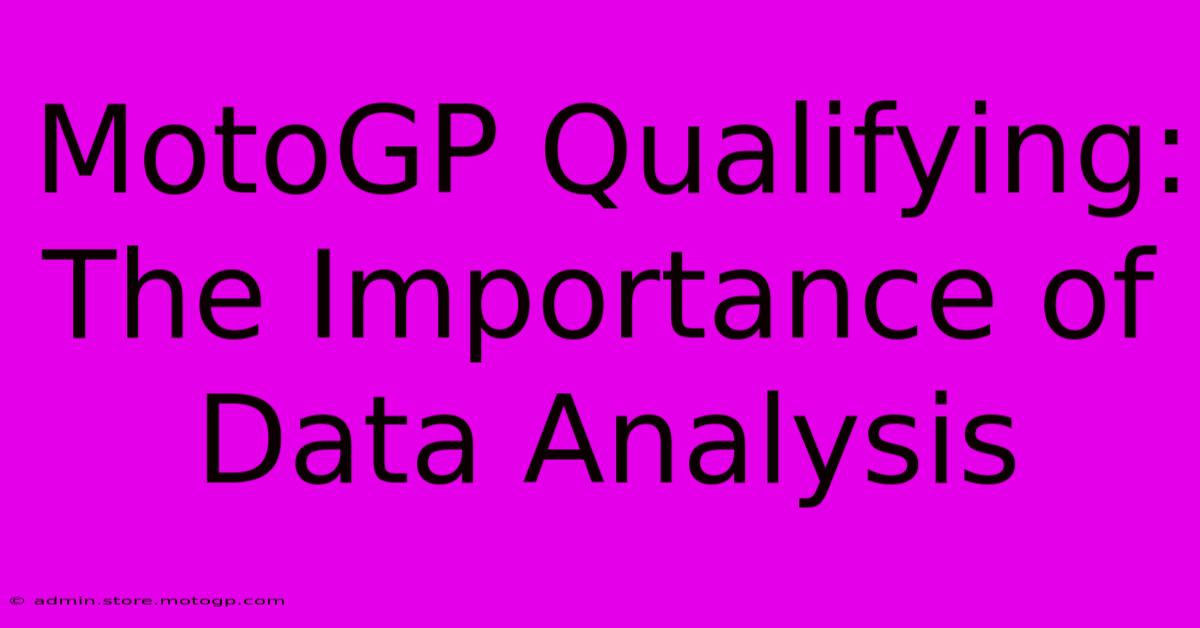MotoGP Qualifying: The Importance Of Data Analysis

Table of Contents
MotoGP Qualifying: The Importance of Data Analysis
MotoGP qualifying. The pressure is immense, the stakes are high, and the margin for error is razor-thin. Securing a pole position can be the difference between a podium finish and a fight for points, or even worse. But in today's hyper-competitive world of Grand Prix motorcycle racing, raw talent alone isn't enough. Data analysis is becoming increasingly crucial to success, playing a pivotal role in optimizing bike setup, rider performance, and ultimately, qualifying performance.
Understanding the Data Deluge
Modern MotoGP bikes generate a staggering amount of data during each session. Telemetry from various sensors throughout the motorcycle – measuring everything from engine RPM and throttle position to suspension travel and lean angle – provides a rich tapestry of information. This data, combined with rider feedback and track conditions, forms the bedrock of effective data analysis in MotoGP qualifying.
Key Data Points for Analysis:
- Lap Times & Sector Times: Analyzing lap times and sector times allows teams to pinpoint areas for improvement, identifying slow sections of the track that need attention.
- Tire Performance: Tire pressure, temperature, and wear are critical. Data analysis reveals optimal tire strategies and helps predict performance degradation over multiple laps.
- Braking & Acceleration: Analyzing braking points, braking distances, and acceleration profiles helps identify areas where the rider or bike can gain or lose crucial milliseconds.
- Electronics & Engine Data: Understanding engine performance, traction control, and other electronic systems is crucial for fine-tuning the bike for optimal qualifying performance.
- Rider Input & Feedback: Subjective rider feedback, though qualitative, is invaluable when combined with objective data. It helps to identify areas where the bike doesn't feel optimal, even if the telemetry doesn't immediately reveal problems.
From Data to Decisive Advantage: How Teams Leverage Analysis
Data analysis in MotoGP qualifying isn't just about number crunching; it's about intelligent interpretation and strategic application. Teams employ sophisticated software and dedicated engineering staff to translate raw data into actionable insights. Here’s how:
1. Identifying Weak Points:</h3>
By comparing a rider's performance against their own previous laps and the competition's best times, teams can quickly identify weak points in their setup or riding style. This allows for targeted adjustments during the limited practice and qualifying time.
2. Optimizing Bike Setup:</h3>
Data analysis helps fine-tune the bike’s settings for the specific track and conditions. Adjustments to suspension, electronics, and even aerodynamics can be made based on the data, maximizing grip and stability for optimal lap times.
3. Predicting Tire Degradation:</h3>
Analyzing tire data helps teams choose the right tire compounds and predict their performance over multiple laps. This is crucial for managing tire wear during a qualifying session and ensuring the rider has optimal grip throughout their final flying laps.
4. Enhancing Rider Performance:</h3>
Data provides feedback for riders, highlighting areas where they can improve their lines, braking, or acceleration. This empowers riders to make adjustments to their riding style and maximize their performance.
5. Strategic Decision Making:</h3>
Data analysis informs strategic decisions during qualifying. Should the team focus on single-lap performance or practice tire management? The data helps guide these critical choices.
The Future of Data Analysis in MotoGP Qualifying
The role of data analysis in MotoGP qualifying is only set to grow. With advancements in technology and sensor capabilities, even more granular data will be collected and analyzed. Expect to see:
- Advanced Machine Learning: AI and machine learning will be used to identify patterns and make predictions with even greater accuracy.
- Real-Time Data Analysis: Teams will be able to analyze data in real-time during qualifying, allowing for immediate adjustments and optimization.
- Simulation & Modeling: Sophisticated simulations will allow teams to test different setups and strategies virtually before applying them on the track.
In conclusion, data analysis has become an indispensable tool in the quest for MotoGP qualifying success. It's no longer enough to rely solely on instinct and experience; teams that master data analysis are gaining a crucial competitive edge, transforming raw data into a winning formula. The future of MotoGP is undoubtedly data-driven.

Thank you for visiting our website wich cover about MotoGP Qualifying: The Importance Of Data Analysis. We hope the information provided has been useful to you. Feel free to contact us if you have any questions or need further assistance. See you next time and dont miss to bookmark.
Featured Posts
-
F1 Parking Pass The Must Have For Race Day
Feb 20, 2025
-
Lot F Your Circuit Of The Americas Parking Advantage
Feb 20, 2025
-
Moto Gp Sprint Races Analyzing The Results
Feb 20, 2025
-
F1 Cota Qualifying For Glory
Feb 20, 2025
-
Fast Track To The Finish Line F1 Shuttles
Feb 20, 2025
